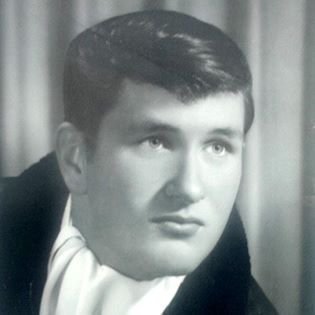In honor of Veterans’ Day – Finding a hero right here at home
AX 2 J. G. Johnny Jones thinks about the men that were left behind during the Viet Nam war. (Submitted Photos)
Most heroes don’t think they are deserving of the title. Most of them say they were just doing their job. Most veterans will tell you they are not heroes, but they are. Their sacrifice and willingness to give their life for their country prove they are heroes in their own right. Anytime someone is responsible for saving another’s life, they are a hero.
Johnny Jones earned the title of hero during his time in the military with HS 6, Search and Rescue.
While serving in the Navy in Viet Nam from 1967 to 1968, Johnny Jones knew the reality of war first hand. There were times on rescue missions, he didn’t think he would make it out alive, much less make it home. If it had been up to the Viet Cong, he would not have come home.
“I have to admit there were many times I was so afraid that I would shake uncontrollably,” Jones said. “I think I was scared to death. The rescue missions we went on were very dangerous. We never wanted to leave anyone behind, but sadly sometimes we had no choice.”
In a typical mission, they would be launched from a destroyer in a HH 3A helicopter with a maximum speed of 120 miles per hour.
“When we took off, we would test and man the guns,” he explained. “While in flight to our destination, we had time to reflect on our mission and where we were. We knew no one liked us over there. They called us ‘dog meat’ because if we were captured by civilians, they would chop us up and feed us to their dogs.”
In the book, Leave No Man Behind, George Galdorisi describes a mission that Jones was on.
Lt. Vern Von Sydow, Lt. Jim Rooney, AXAN Ronald V. Cockerham, and AX2 Johnny Jones approached dangerous Hon Mat Island, about ten miles off the mouth of the Song Ca River across from Vinh to attempt a dangerous rescue. Von Sydow took a calculated risk, descending to one hundred feet and racing through the effective range arcs of the AA guns rather than making a safer, but time-consuming detour around.
Rooney heard a beeper and Von Sydow got a cut on it. They could see muzzle flashes illuminating the columns of water rising around two U.S. destroyers. They headed straight in and Rooney spotted the survivor in his one-man raft and Von Sydow took the controls and horsed the big helicopter into a manual hover over the raft, despite the growing darkness. The rotor wash blew the raft out from under the helicopter.
Ignoring the danger of a huge column of water rising less than a hundred yards from the stationary helicopter, Jones directed Von Sydow to hover upwind and back down past the survivor, Commander Woolcock, pulling the extended hoist cable and floating horse collar over the raft. Shells were landing very close to their position. Woolcock grabbed the cable, followed it to the horse collar, and wriggled into it backwards. Before he could get correctly turned in the horse collar, Jones hit the raise switch and brought Woolcock to the door and into the safety of the helicopter with the help of Cockerham.
On many missions like the one described in the book, they took on enemy fire. Jones said that it sounded like rocks hitting the metal on the helicopter. Many times he would see parts of the helicopter fly by after being hit. The crew all knew they could be shot down and captured on any mission.
“We had an authenticator that we would use if we were ever shot down and captured because the enemy would use our radio to draw our pilots in to rescue us,” he said. “My challenge word was ‘Teddy’ and I would answer ‘dog’ because that was my dogs name. The enemy would not have known that.”
Jones said that he has lost many nights sleep since serving during the Viet Nam war.
“I never lost sleep over anyone that I had to kill, because it was either me or him. I have, however, lost sleep over the men we had to leave behind. I never wanted to leave anyone behind.”
One of the most vivid memories he has was an attempted rescue mission in July of 1967. Lt. Hartman, a Navy A 4 pilot was shot down near Phu Ly. In route to rescue Lt. Hartman, the hoist operator and rear gunner, Chatterton, took a 14 ½ millimeter to the chest. The initial hit did not kill him, but the shock wave that the hit caused took his life.
“I remember that day as if it was yesterday,” Jones said. “We had to swab the blood from the floor of the helicopter but we could never get all of it. It would get into the cracks in the floor. Every time we climbed into the copter, the smell from the blood was horrible. It reminded us that death was very close to us.”
“We had taken so much fire on the mission to rescue Lt. Hartman that we had to return to the ship. They sent another crew to get him but they immediately took a lot of fire. They took a direct hit and their instrument panel exploded which took out their radio and hydrolics. They lost one engine power so they were told to return to the ship.”
“The decision was made to try a night rescue. The crew was Lt. Peterson, Ensign Frye, Petty Officer Jackson from Texas and Petty Officer McRaven. They took a circular route and all was well because they were not taking on any fire. But, that did not last because they overshot Lt. Hartman. When they came around they flew over a flak trap. The pilot held the mike open shouting Mayday Mayday. You could hear the screams of the crew right before they exploded upon contact with a hill.”
“On this one rescue mission to pick up Lt. Hartman, the Navy sent 3 helicopters. Five of the twelve crewmen died. Even though they knew it probably would not be a good outcome, three other crews volunteered to go get Lt. Hartman. “Harbormaster”, the Commander of Search and Rescue, denied their request. Hartman begged “Harbormaster” not to leave him there, but he gave the news to Lt. Hartman that he would not be rescued.”
“Lt. Hartman never came home,” Jones said. “We never knew what happened to him. That is a hard one to deal with. We never wanted to leave any soldier behind.”
Jones talked about the war, the rescues he participated in and then described the most difficult part of the war.
“The hardest thing was not the war itself,” he explained. “The hardest thing was to see the way our soldiers were treated when they returned home. We were subjected to ribbon spitters, young girls that spit on the soldiers. I remember being in the airport in San Francisco when a girl came up and spit on me. After that I never wore my uniform in public again.”
Jones continued. “I still hold a grudge against Jane Fonda. I refuse to support her in any way. I won’t watch any of her movies because of what she did during the Viet Nam war.”
Jones recalls his first rescue mission before he went to Viet Nam. An A-4 pilot was doing practice runs and hit a wire. He had to eject and hit the water face first, still strapped in his seat. When he hit the water, his heart ruptured. There were sharks and the water was frigid.
“I jumped in for the rescue. I gave him mouth to mouth, but soon realized he was dead. I signaled the mission was recovery not rescue. I was so cold but I did not want to leave him there. I saw the wedding ring on his hand and knew he had a wife and possibly kids back home. I sat in the water with him. I insisted they take him into the boat before me. It took hours for me to warm up because I was in normal flight gear in that frigid water. I have always thought my first rescue was a failure.”
Jones has memories of his time in the military, some good and some bad that will stay with him forever. He is a veteran that appreciates the freedoms that we have here in America because he knows first hand the price that was paid for them. He is thankful for those that have served in the military to ensure our freedom. He will never forget those he served with, those that were saved or those that were left behind.
Per Internet search:
Lt. Cmdr. Hartman’s remains were returned to the US by the Viet Nam government in 1974.

